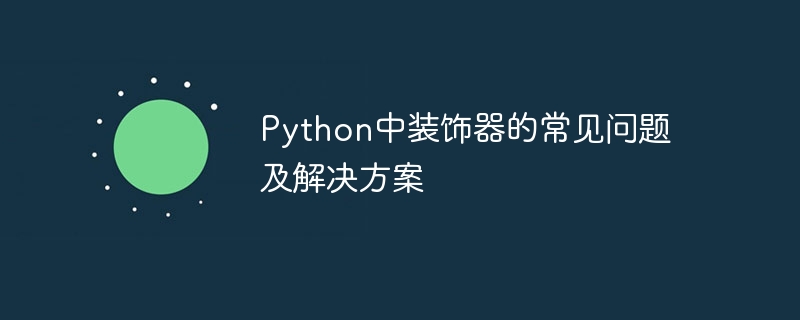
Python中裝飾器的常見問題及解決方案
def decorator(func):
def inner_function():
print("Before function")
func()
print("After function")
return inner_function
@decorator
def hello():
print("Hello, World!")
hello()輸出結果為:
Before function Hello, World! After function
這個裝飾器函數將在原始函數執行前後列印額外的資訊。
def decorator_with_args(arg1, arg2):
def decorator(func):
def inner_function(*args, **kwargs):
print(f"Decorator arg1={arg1}, arg2={arg2}")
func(*args, **kwargs)
return inner_function
return decorator
@decorator_with_args("Hello", 42)
def hello(name):
print(f"Hello, {name}!")
hello("World")輸出結果為:
Decorator arg1=Hello, arg2=42 Hello, World!
這個範例中,裝飾器函數decorator_with_args接收兩個參數,然後傳回一個新的裝飾器函數。新的裝飾器函數接受目標函數的參數,並在列印參數的同時呼叫目標函數。
@functools.wraps裝飾器來保留原始函數的元資訊。這樣可以避免因裝飾器修改了函數名稱、文件字串等資訊而導致偵錯困難。 import functools
def decorator(func):
@functools.wraps(func)
def inner_function(*args, **kwargs):
print("Before function")
func(*args, **kwargs)
print("After function")
return inner_function
@decorator
def hello():
"""This is the Hello function."""
print("Hello, World!")
print(hello.__name__)
print(hello.__doc__)輸出結果為:
hello This is the Hello function.
這個例子中,@functools.wraps(func)保留了原始函數的__name__和__doc__屬性。
def decorator(cls):
class NewClass(cls):
def decorated_method(self):
print("Decorated method")
super().decorated_method()
return NewClass
@decorator
class MyClass:
def decorated_method(self):
print("Original method")
obj = MyClass()
obj.decorated_method()輸出結果為:
Decorated method Original method
這個範例中,裝飾器函數建立了一個新的類別NewClass,該類別繼承自原始類別MyClass,並在原始方法中增加了額外的功能。
總結:
裝飾器是Python中一個非常強大的功能,可以用來修改已有函數或類別的行為。使用裝飾器時,可能會遇到一些問題,例如如何傳遞額外的參數、如何保留原始函數的元資訊等。上述範例提供了一些常見問題的解決方案,並透過程式碼範例進行了詳細說明。透過靈活運用裝飾器,可以為我們的程式碼增加更多的可擴充性和可重複使用性。
以上是Python中裝飾器的常見問題及解決方案的詳細內容。更多資訊請關注PHP中文網其他相關文章!




